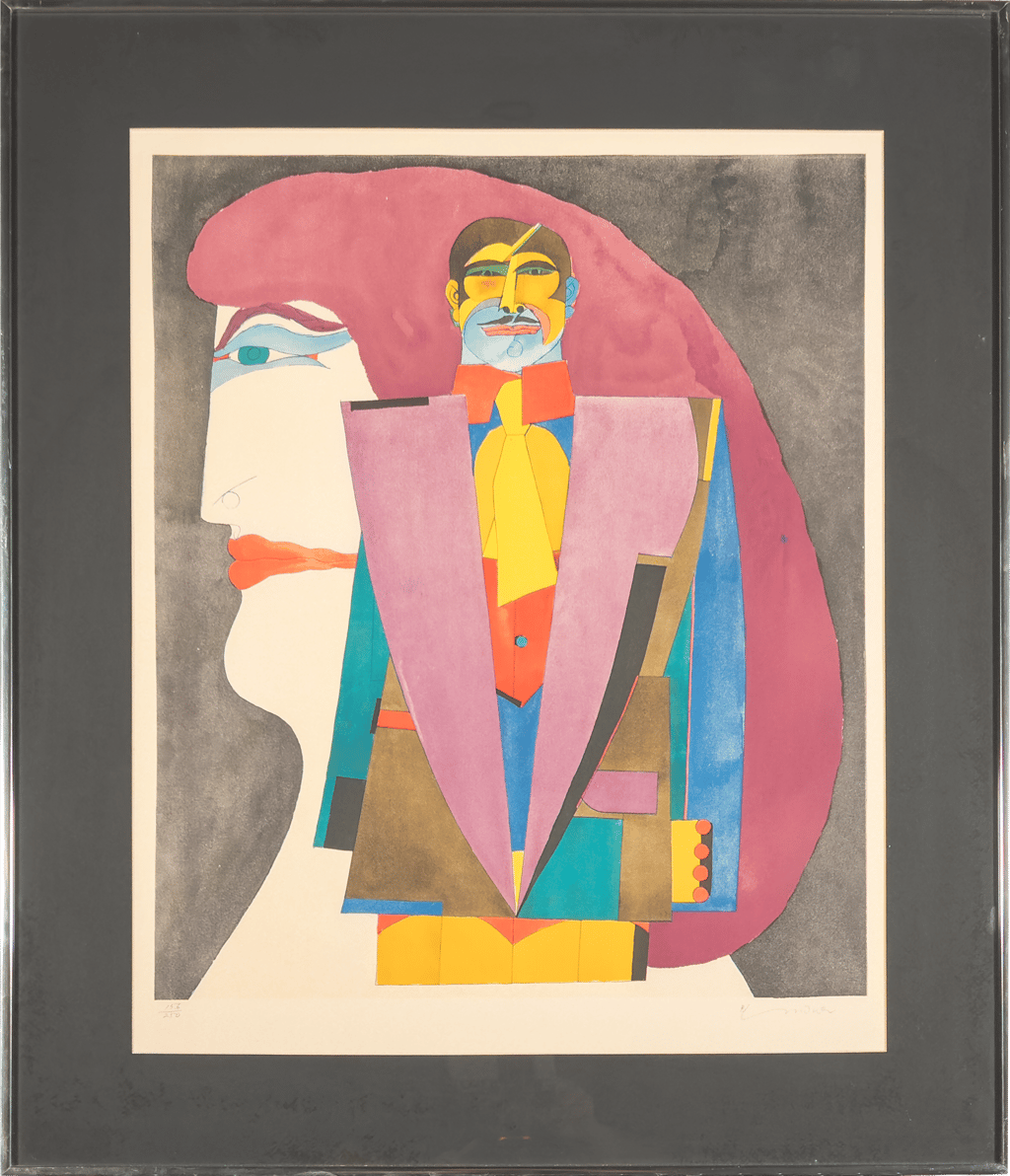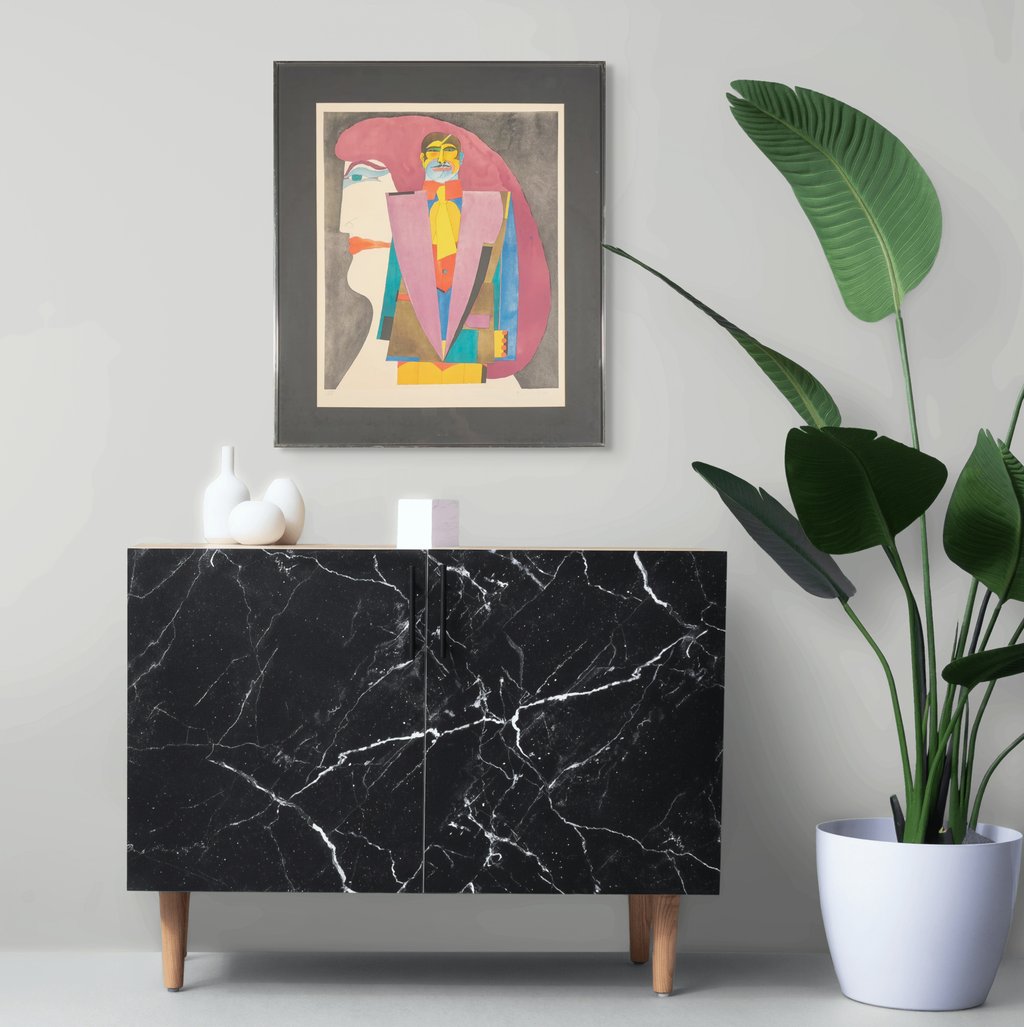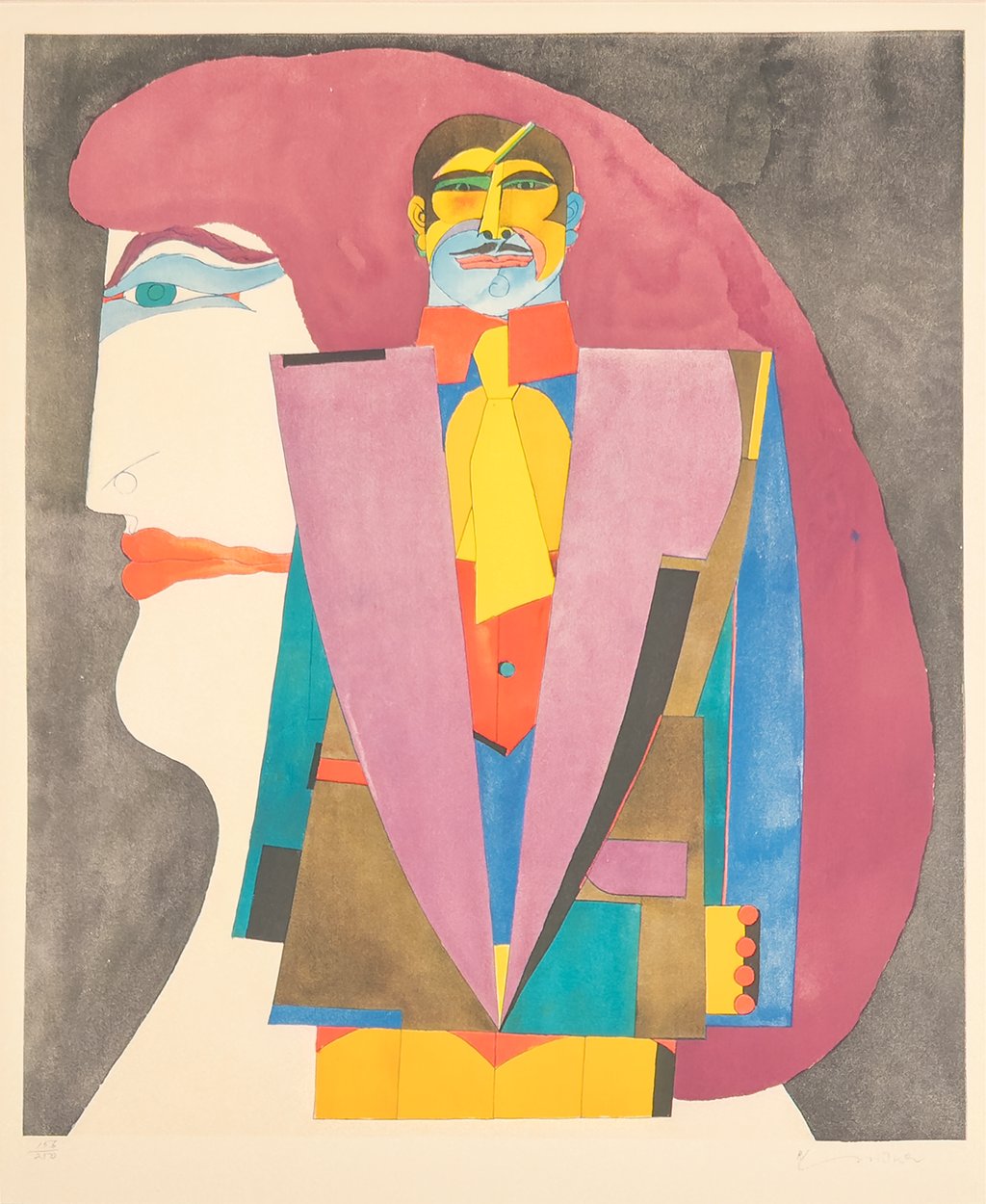The couple; Afternoon portfolio 156/250
33 x 28 in (83.8 x 71.1 cm) including frame


Richard Lindner
Richard Lindner was born on November 11, 1901, in Hamburg, Germany, to Jüdell (Julius) Lindner, a commercial clerk and member of the High German Jewish Congregation Altona, and Mina Bornstein, who was born in New York to German parents. In 1905, his family moved to Nuremberg, where his mother later operated a custom-fitting corset business beginning in 1913. Lindner initially worked as a commercial clerk before enrolling at the Kunstgewerbeschule (Arts and Crafts School) in Nuremberg in 1922, where he studied life drawing and oil painting. He became a Master Pupil under Professor Max Körner in 1926 and participated in various design competitions. From 1925 to 1927, he lived in Munich and studied at the Kunstakademie, later moving briefly to Berlin in 1927 before returning to Munich in 1929.
In 1930, Lindner married fellow student Elsbeth Schülein and established himself as a successful commercial artist in Munich's Schwabing district. He worked as an illustrator for newspapers and magazines including Münchner Neueste Nachrichten and Münchner Illustrierte Presse for the publisher Knorr and Hirth, where he served as art director. His commercial work during this period was noted in the graphic arts journal Das Zelt, marking the first publication about his artistic activities. However, his career in Germany was cut short when Hitler was declared Chancellor in 1933, forcing Lindner to flee to Paris due to his Jewish heritage.
Lindner lived in Paris from 1933 to 1941, working as a commercial artist and illustrator. His wife Elsbeth found success as a fashion illustrator for Vogue and Jardin des Modes. When World War II broke out in 1939, both Richard and Elsbeth were interned by French police as German refugees. Richard was imprisoned in a camp at Villemalard near Blois, while Elsbeth was released first and emigrated to the United States. In 1941, Richard arrived at the Port of New York on March 17, reuniting with his wife. He quickly established himself as a magazine and book illustrator, with one of his first published works appearing in Town & Country magazine in October 1941.
During the 1940s, Lindner worked as a successful freelance illustrator for major American publications and advertising companies, including commissions from the Container Corporation of America. He separated from Elsbeth in 1942 and they divorced in 1944, though she continued using the professional name Jacqueline Lindner. He became an American citizen on November 15, 1948. During this period, he formed friendships with fellow émigré artists and writers, including Saul Steinberg, Eugene Berman, René Bouché, and Hedda Sterne. In 1946, he decided to pursue painting seriously, completing his first major work, Wunderkind, and beginning studies for his significant painting The Meeting in 1953.
Lindner began his teaching career in 1952 as a part-time instructor in graphic expression at the Pratt Institute in Brooklyn, where he continued until 1966. His first solo exhibition was held at the Betty Parsons Gallery in New York in January-February 1954, though no paintings sold. In 1957, he received the William and Noma Copley Foundation Award and was appointed visiting artist at Yale University School of Art and Architecture. His work during this period featured distinctive imagery drawn from New York urban life, including streetwalkers, circus performers, and authority figures, rendered with harsh colors, hard outlines, and mechanical qualities that reflected both his European artistic training and American experiences.
Lindner's mature artistic style emerged in the 1960s, characterized by robotic, corseted female figures and enigmatic male characters that blended elements of German Expressionism, Surrealism, and Cubism with American Pop Art sensibilities. Major museums began acquiring his work, with the Museum of Modern Art purchasing The Meeting in 1962. He participated in documenta IV in Kassel in 1968 and had his first museum retrospective that year, traveling from Leverkusen to several German cities. In 1969, at age sixty-eight, he married French painter Denise Kopelman, and the couple began dividing their time between New York and Paris. Lindner was elected to the American Academy of Arts and Letters in 1972 and received the Lichtwark Award from the city of Hamburg in 1970. He died of a heart attack on April 16, 1978, at his New York apartment at age seventy-seven and was buried at Westchester Hills Cemetery in Hastings-on-Hudson, New York.
September Canadian & International Art Auction
September 12 - September 25, 2025
212 McDermot Ave, Winnipeg MB
(204) 255-5690
mayberryfineart.com
[email protected]
Contact us to make an appointment to preview this item or to sell similar works.
|
Bidding Range
|
Increment
|
|---|---|
| $0.00 - $50.00 | $1.00 |
| $50.00 - $100.00 | $5.00 |
| $100.00 - $500.00 | $10.00 |
| $500.00 - $1,000.00 | $25.00 |
| $1,000.00 - $5,000.00 | $50.00 |
| $5,000.00 - $10,000.00 | $100.00 |
| $10,000.00 - $20,000.00 | $200.00 |
| $20,000.00 - $50,000.00 | $500.00 |
| $50,000.00 - $100,000.00 | $1,000.00 |
| $100,000.00+ | $5,000.00 |
Login or register a BidLots.com account to participate in any auction. Track specific lots and artists with real-time notifications on all bidding activity.
Bidding approval requires three simple steps:
1. Create a Bid Lots account
2. Confirm your email address
3. Create a valid billing profile
Bid Lots and/or the auctioneer may choose to revoke your bidding privileges if your account is not in good standing or your activity is in conflict with our standard terms and conditions of sale.
The buyer’s premium is an additional percentage charged to the winning bidder. The buyer’s premiums may vary from auction to auction, typically ranging from 10% to 20%. Buyer’s premiums will be displayed on detailed lot listings and paddle registration forms.
Bidding begins at the reserve price and advances at set increments based on the bidding range. The specific bidding increments may vary from auction to auction, however the next bid and subsequent increments will always be clearly defined on detailed lot listings. Maximum Bids and Single Bids can only be placed within the pre-defined bidding increments ensuring that no two bidders can place identical bids on an item. View individual lot detail pages to see a complete range of bidding increments for that item.
Requests to cancel a single bid are at the sole descretion of the auctioneer. Maximum bids can be increased but cannot be decreased unless premitted by the auctioneer. Requests to cancel a bid or to alter a maximum bid will be denied if the specific lot is scheduled to close in less than 24 hours or if the lot has significant interest or activity.
To request that a bid be cancelled or to change a maximum bid use the "Ask a question" button on the detailed lot listing.
You will receive an email notification when you have successfully won an auction. You will also see the item listed on your "Bidding Results" page and if you are logged into the site you will see a highlighted message on the auction catalogue pages and auction listings.
Shipping requirements may vary on different items depending on location and size or weight of an item. When registering for a specific auction you will be provided options to clarify your preferred shipping instructions. The auctioneer will also review and provide specific shipping quotes or options following the close of an auction. If you have specific shipping requirements or are unsure of the shipping constraints on a specific item please contact the auctioneer prior to bidding.
Following the close of an auction the auctioneer will provide a detailed invoice for all items you have won. They may contact you before a final invoice is prepared to confirm or review specific shipping instructions. Payment is due once a final invoice is provided and can be submitted online by credit card, or made by EFT (Electronic Fund Transfer), bank draft or international wire transfer. Any outstanding balance will be automatically charged to your registered credit card 5 days following the close of an auction.


